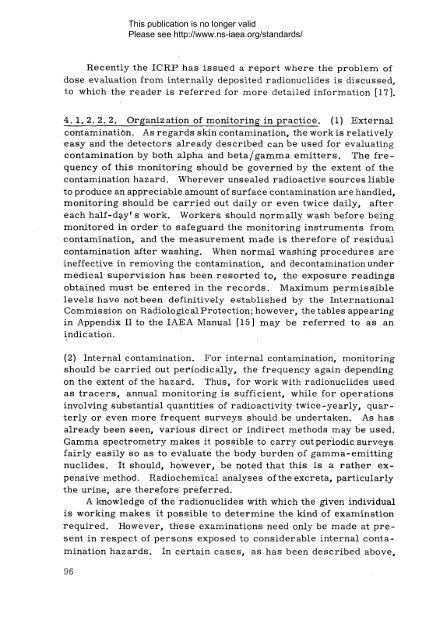Safety_Series_025_1968 - gnssn - International Atomic Energy ...
Safety_Series_025_1968 - gnssn - International Atomic Energy ...
Safety_Series_025_1968 - gnssn - International Atomic Energy ...
Create successful ePaper yourself
Turn your PDF publications into a flip-book with our unique Google optimized e-Paper software.
This publication is no longer validPlease see http://www.ns-iaea.org/standards/Recently the ICRP has issued a report where the problem ofdose evaluation from internally deposited radionuclides is discussed,to which the reader is referred for more detailed information [17].4. 1. 2. 2. 2. Organization of monitoring in practice. (1) Externalcontamination. As regards skin contamination, the work is relativelyeasy and the detectors already described can be used for evaluatingcontamination by both alpha and beta/gamma emitters. The fr e quency of this monitoring should be governed by the extent of thecontamination hazard. Wherever unsealed radioactive sources liableto produce an appreciable amount of surface contamination are handled,monitoring should be carried out daily or even twice daily, aftereach half-day's work. Workers should normally wash before beingmonitored in order to safeguard the monitoring instruments fromcontamination, and the measurement made is therefore of residualcontamination after washing. When normal washing procedures areineffective in removing the contamination, and decontamination undermedical supervision has been resorted to, the exposure readingsobtained must be entered in the records. Maximum perm issiblelevels have not been definitively established by the <strong>International</strong>Commission on Radiological Protection; however, the tables appearingin Appendix II to the IAEA Manual [15] may be referred to as anindication.(2) Internal contamination. For internal contamination, monitoringshould be carried out periodically, the frequency again dependingon the extent of the hazard. Thus, for work with radionuclides usedas tracers, annual monitoring is sufficient, while for operationsinvolving substantial quantities of radioactivity twice-yearly, quarterlyor even more frequent surveys should be undertaken. As hasalready been seen, various direct or indirect methods may be used.Gamma spectrometry makes it possible to carry out periodic surveysfairly easily so as to evaluate the body burden of gamma-emittingnuclides. It should, however, be noted that this is a rather expensivemethod. Radiochemical analyses of the excreta, particularlythe urine, are therefore preferred.A knowledge of the radionuclides with which the given individualis working makes it possible to determine the kind of examinationrequired. However, these examinations need only be made at presentin respect of persons exposed to considerable internal contaminationhazards. In certain cases, as has been described above,96
















